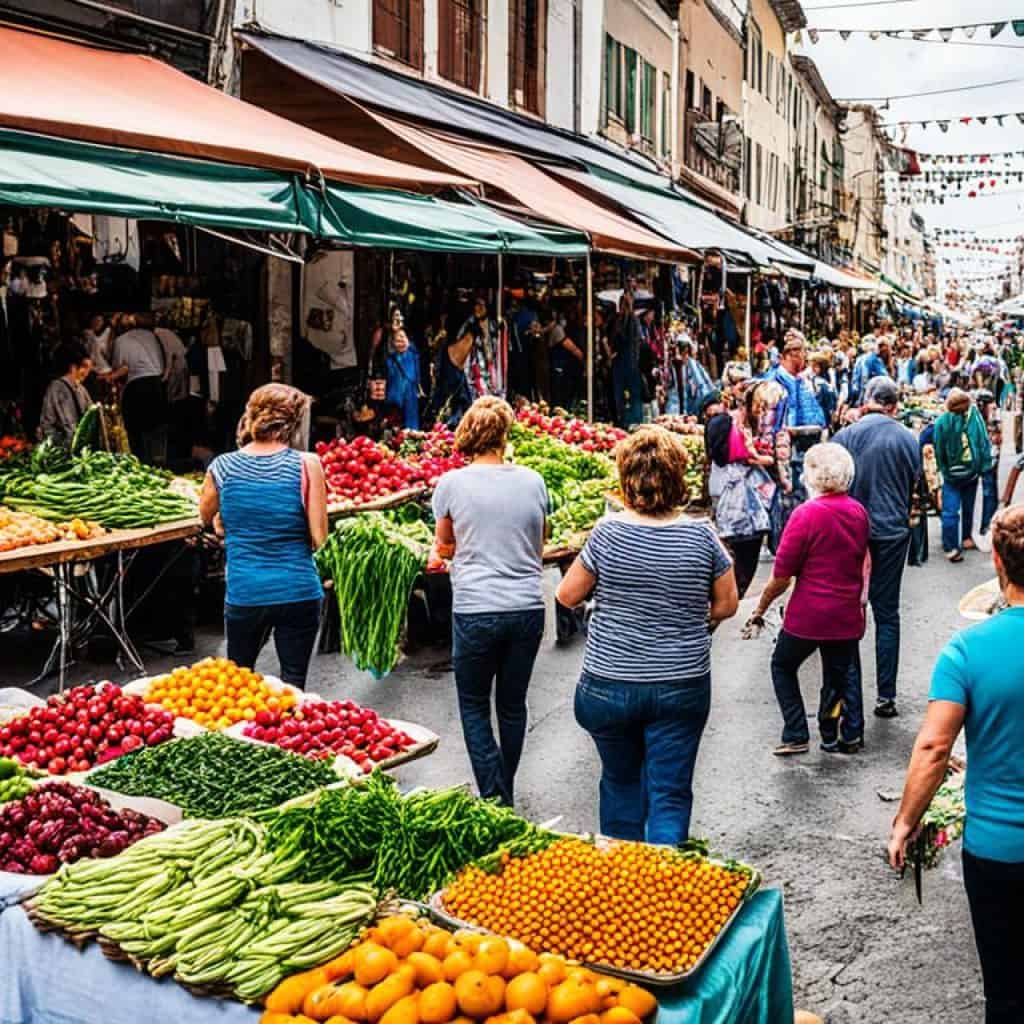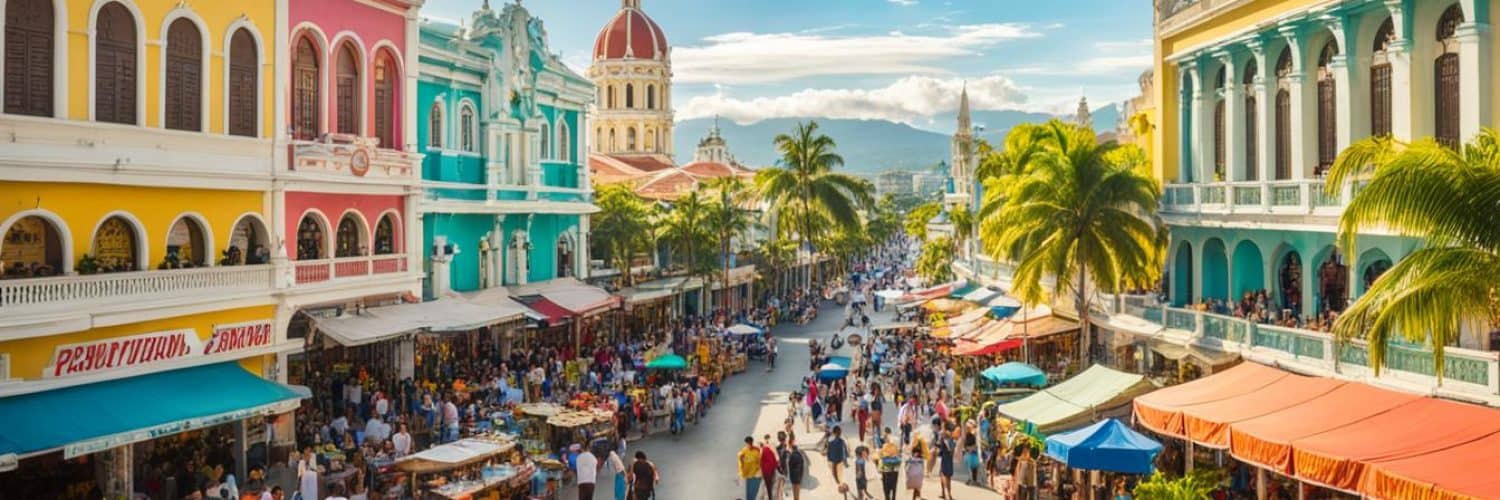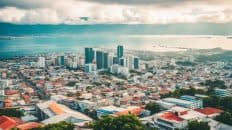Welcome to the vibrant and diverse District of Cebu in the Philippines! Are you ready to embark on an extraordinary journey filled with cultural wonders, historical landmarks, and breathtaking natural beauty? Prepare to be captivated by the bustling city of Cebu City, immerse yourself in the tranquility of stunning beaches, and discover the hidden gems scattered throughout the district.
But here’s the real question: Have you truly explored everything the District of Cebu has to offer? Do you think you know the heart and soul of this captivating destination? Prepare to challenge your beliefs and embark on an adventure that will leave you in awe.
Key Takeaways:
- Discover the vibrant and diverse District of Cebu in the Philippines.
- Immerse yourself in the cultural, historical, and natural attractions the district has to offer.
- Explore the bustling city of Cebu City and its hidden gems.
- Uncover the beauty of the stunning beaches and landscapes in the surrounding areas.
- Challenge your beliefs and embrace the true heart and soul of the District of Cebu.
Best Time to Go to Cebu
Planning a trip to Cebu? The best time to visit this beautiful destination is during the dry and summer season, which spans from December to May. This period offers the most favorable weather conditions for outdoor activities such as swimming, diving, and sightseeing.
During the dry and summer season, Cebu experiences lower chances of rainfall, allowing you to fully enjoy the stunning beaches, lush landscapes, and vibrant city life. The pleasant temperatures and clear skies create the perfect backdrop for exploring all that Cebu has to offer.
One of the highlights of visiting Cebu in January is experiencing the world-renowned Sinulog Festival. This annual event celebrates the Santo Niño (Child Jesus) and showcases the rich cultural heritage of Cebu. The festival attracts millions of visitors from around the world who gather to witness the vibrant street parades, traditional dances, and religious processions.
The climate and weather in Cebu are generally tropical, with warm temperatures throughout the year. However, it’s important to note that the months of December to May are considered the dry and summer season, providing the best conditions for outdoor exploration.
When packing for your trip to Cebu, be sure to bring lightweight and breathable clothing suitable for the tropical climate. Opt for comfortable footwear, swimwear, and sun protection, including hats and sunscreen, to ensure a pleasant and enjoyable stay.
“The best time to visit Cebu is during the dry and summer season, from December to May. Enjoy the favorable weather and explore the vibrant city, beautiful beaches, and cultural festivities.”
With its ideal weather conditions and exciting festivals, the dry and summer season is undoubtedly the best time to visit Cebu. Plan your trip and immerse yourself in the captivating beauty, warm hospitality, and rich culture of this enchanting destination.
How to Get to Cebu
There are several convenient ways to reach Cebu and explore all that this vibrant district has to offer. Whether you prefer flying or taking a ferry, getting to Cebu is easy and hassle-free. Once you arrive, you’ll find a variety of transportation options to help you navigate the city and its surroundings.
Flights to Cebu
The most convenient way to reach Cebu is by taking a flight to the Mactan-Cebu International Airport. This modern airport serves as the gateway to the district and offers numerous domestic and international flights. Major airlines such as Philippine Airlines, Cebu Pacific, and AirAsia operate regular flights to and from Cebu, providing you with a range of options to suit your schedule and budget.
Ferry to Cebu
If you’re coming from other islands in the Philippines, you can also opt to travel by ferry. Cebu has several ports that serve as entry points for ferry services. Popular ferry routes include those from Manila, Bohol, Dumaguete, and Leyte. Ferry travel not only offers a scenic journey but also allows you to experience the beauty of the Philippine archipelago.
Getting Around Cebu
Once you arrive in Cebu, getting around the district is a breeze. Cebu City itself has a well-established transportation system consisting of taxis, buses, jeepneys, and tricycles. Taxis are readily available and provide a convenient way to travel between different areas of the city. Buses and jeepneys are the more affordable options, offering routes that cover various points of interest.
If you’re looking for a unique local experience, hop on a colorful jeepney, which is an iconic mode of transportation in the Philippines. Tricycles, on the other hand, are best suited for short-distance travel within neighborhoods or smaller towns outside of Cebu City.
No matter your preferred mode of transportation, exploring the district of Cebu is made easy by its well-connected transportation network.
Where to Stay in Cebu
When planning a trip to Cebu, finding the perfect accommodation is essential. Fortunately, this vibrant district in the Philippines offers a wide range of options to suit every traveler’s needs and preferences.
Budget Accommodations
If you’re traveling on a budget, Cebu has plenty of affordable hotels and guesthouses that offer comfortable stays without breaking the bank. These accommodations provide value for money, often located in convenient areas close to tourist attractions and transportation hubs. You’ll find clean rooms, friendly service, and the essential amenities needed for a pleasant stay in Cebu.
Mid-Range Accommodations
For those seeking a little more comfort and convenience, mid-range accommodations in Cebu offer a step up in quality and amenities. These hotels are often well-appointed, providing spacious rooms, modern facilities, and extra services such as in-house restaurants, swimming pools, or fitness centers. Mid-range accommodations in Cebu cater to travelers who want added comfort without sacrificing affordability.
Luxury Accommodations
If you’re looking to indulge and enjoy a luxurious stay in Cebu, the district offers a selection of top-notch hotels and resorts that cater to your every need. These luxury accommodations boast elegant and stylish interiors, world-class facilities, breathtaking views, and impeccable service. From spa retreats to beachfront villas, Cebu’s luxury hotels will pamper you with their opulence and create unforgettable experiences.
Pro Tip: When booking accommodation in Cebu, consider factors such as location, proximity to attractions, and specific amenities that are important to you.
To help you make an informed decision on where to stay in Cebu, here’s a comparison table of budget, mid-range, and luxury accommodations:
| Accommodation Type | Features | Price Range |
|---|---|---|
| Budget Accommodations | Basic amenities, affordability, convenient locations | $-$$ |
| Mid-Range Accommodations | Comfortable rooms, extra facilities (restaurants, pools, etc.) | $$-$$$ |
| Luxury Accommodations | Premium amenities, world-class service, stunning views | $$$-$$$$$ |
Whether you’re on a tight budget, seeking added comfort, or wanting a luxurious experience, Cebu offers a wide range of accommodation options to suit your needs. Take advantage of the diverse choices available and make your stay in Cebu a memorable one.
What to See and Do in Cebu City
Cebu City, the capital of the district, offers a wealth of attractions for visitors to explore. Whether you are interested in history, culture, or stunning architectural landmarks, this vibrant city has something for everyone. Here are a few must-see sights and activities to add to your itinerary:
Fort San Pedro
Step back in time and visit Fort San Pedro, a historic military defense structure that dates back to the Spanish colonial era. Explore the ancient walls, walk along the battlements, and immerse yourself in the rich history of this fascinating landmark. Don’t forget to bring your camera to capture the breathtaking views of Cebu City’s skyline.
Basilica del Santo Niño
Pay a visit to the Basilica del Santo Niño, home to the famous Santo Niño statue. This religious icon is highly revered by the locals and attracts devotees from all over the country. Marvel at the beautiful architecture of the basilica and join the faithful in prayer and reflection.
Magellan’s Cross
“One of the most iconic symbols of Cebu City’s rich history is Magellan’s Cross. This wooden cross represents the arrival of Christianity in the Philippines and commemorates the first Catholic mass held in the country.”
Take a moment to admire this significant historical symbol and learn about its importance in Filipino culture and heritage.
Yap-Sandiego Ancestral House
For a glimpse into the city’s rich history and culture, visit the Yap-Sandiego Ancestral House. This well-preserved 17th-century house showcases traditional Filipino-Spanish architecture and offers a fascinating look into the lifestyle of the affluent families of that era. Explore each room, admire the antique furniture and artifacts, and feel transported back in time.

With these noteworthy attractions, Cebu City promises an enriching and memorable travel experience. Immerse yourself in the city’s history, cultural heritage, and architectural marvels, and discover the vibrant heart of the District of Cebu.
| Attraction | Description |
|---|---|
| Fort San Pedro | A historic military defense structure that offers stunning views of Cebu City’s skyline. |
| Basilica del Santo Niño | Home to the famous Santo Niño statue, this basilica is a significant religious symbol in the Philippines. |
| Magellan’s Cross | Commemorates the arrival of Christianity in the Philippines and holds great cultural significance. |
| Yap-Sandiego Ancestral House | A well-preserved house that showcases traditional Filipino-Spanish architecture and offers a glimpse into the city’s history. |
What to See and Do in North Cebu
North Cebu is a treasure trove of natural beauty and unique attractions that are sure to captivate every traveler. Here are some of the must-see sights and activities in this stunning part of the district.
Malapascua: Diving with Thresher Sharks
If you’re a diving enthusiast, Malapascua should be at the top of your list. This small island is famous for its encounters with thresher sharks, known for their long tails and distinctive appearance. Dive into the crystal-clear waters and get up close with these magnificent creatures for an unforgettable adventure.
Bantayan Island: Paradise of White Sand Beaches
For those seeking blissful relaxation on pristine beaches, Bantayan Island is a true paradise. With its powdery white sand, crystal-clear waters, and laid-back atmosphere, this island is a haven for beach lovers. Swim, sunbathe, or simply unwind as you take in the breathtaking views of the coastline.
Camotes Island: Adventure and Excitement Await
Camotes Island offers a wealth of exciting activities for the adventurous traveler. Explore hidden caves, go cliff diving into turquoise lagoons, or embark on a kayaking adventure through mangrove forests. From thrilling activities to stunning natural landscapes, Camotes Island is a playground for outdoor enthusiasts.
“North Cebu is a hidden gem, offering a diverse range of experiences for travelers. From diving with thresher sharks in Malapascua to basking on the white sand beaches of Bantayan Island, there is something for everyone to enjoy. Don’t miss the chance to explore Camotes Island’s unique attractions and embark on exciting adventures. North Cebu is a true paradise waiting to be discovered!”
Top Attractions in North Cebu
| Destination | Highlight |
|---|---|
| Malapascua | Diving with thresher sharks |
| Bantayan Island | White sand beaches |
| Camotes Island | Spelunking, cliff diving, and kayaking |
Whether you’re an adrenaline junkie seeking thrilling adventures or a beach lover in search of pure relaxation, North Cebu has it all. Immerse yourself in the natural beauty, explore the unique attractions, and create unforgettable memories in this enchanting part of the district.
What to See and Do in South Cebu
South Cebu is a treasure trove of breathtaking attractions that are sure to leave you in awe. From sacred shrines to thrilling adventures and stunning natural wonders, there is something for every traveler in this vibrant region.
Simala Shrine
Located in Sibonga, the Simala Shrine is a popular pilgrimage site revered for its miraculous stories. The shrine is home to a beautiful replica of the Virgin Mary and attracts devotees from all over the country. Marvel at the intricate architecture and find solace in the serene surroundings.
Moalboal Sardine Run
If you’re a fan of marine life, don’t miss the Moalboal Sardine Run. Dive into the crystal-clear waters and witness a spectacle like no other as millions of sardines gracefully move in unison. Snorkeling or diving among these shimmering fish is an experience you won’t soon forget.
Canyoneering Kawasan Falls
For thrill-seekers, canyoneering in Kawasan Falls is a must. Strap on your gear and prepare for an adrenaline-pumping adventure through lush jungles, cliff jumps, and natural water slides. Immerse yourself in the beauty of the cascading waterfalls and embrace the thrill of exploring this natural playground.
Osmeña Peak
Rise above the clouds and be rewarded with breathtaking views from Osmeña Peak. This scenic hike takes you through rolling hills and offers panoramic vistas of the surrounding landscapes. As the highest point in Cebu, it’s the perfect spot to watch the sunrise or sunset while being surrounded by nature’s beauty.
South Cebu has a wide range of activities to suit every traveler’s interests. Whether you’re seeking spiritual enlightenment, underwater adventures, thrilling canyoneering, or stunning panoramic views, this region has it all. Plan your trip to South Cebu and immerse yourself in the natural wonders that await you.
What to Eat and Drink in Cebu
One of the highlights of visiting Cebu is sampling the local cuisine. Cebu is famous for its lechon, a roasted pig that is tender and flavorful. Other must-try dishes include kinilaw, a Filipino ceviche, puso or hanging rice, and dried mangoes, which are a popular snack. Make sure to also indulge in the local delicacies and street food that are available throughout the district.
If you’re a meat lover, you can’t miss the opportunity to try Cebu’s famous lechon. The juicy and crispy skin combined with the succulent meat makes it a culinary masterpiece. Whether you enjoy it as a main course or as a centerpiece in a festive celebration, Cebu lechon is a true gastronomic delight.
For seafood enthusiasts, kinilaw should be on your list. This dish features fresh fish or seafood cured in vinegar and seasoned with spices and citrus juices. It’s a refreshing and tangy appetizer that showcases the flavors of Cebu’s bountiful waters.
If you’re looking for a unique dining experience, try puso or hanging rice. It is rice wrapped in woven coconut leaves shaped like a diamond and cooked to perfection. Puso is often served with grilled dishes and provides a delightful combination of flavors and textures.
To satisfy your sweet tooth, don’t miss out on Cebu’s dried mangoes. Known for their intense sweetness and chewy texture, Cebu dried mangoes are a delightful treat that can be enjoyed on their own or used as an ingredient in various desserts.
In addition to these iconic dishes, Cebu offers a wide range of local delicacies and street food that will tantalize your taste buds. From pungko-pungko, a street food concept where you choose from a variety of fried delicacies, to siomai sa tunga, a dumpling dish unique to Cebu, there’s always something new and exciting to discover in the local food scene.
“Cebu’s cuisine is a reflection of its rich culture and diverse influences. From Spanish-inspired lechon to local delicacies, every bite tells a unique story.”
Here’s a taste of what you can enjoy in Cebu:
| Dish | Description |
|---|---|
| Lechon | A whole roasted pig with crispy skin and juicy meat |
| Kinilaw | A Filipino ceviche made with fresh fish or seafood |
| Puso | Hanging rice wrapped in woven coconut leaves |
| Dried Mangoes | Sweet and chewy mango slices dried to perfection |
| Pungko-pungko | A street food concept where you choose from a variety of fried treats |
| Siomai sa Tunga | Cebu’s unique version of dumplings |
Exploring Cebu’s culinary scene is an adventure in itself. Whether you’re dining at a local eatery or enjoying street food, the flavors of Cebu will leave a lasting impression on your taste buds. So don’t miss out on the opportunity to savor the delectable dishes and experience the vibrant food culture of Cebu.
Practical Information and Tips
When planning your visit to Cebu, it’s essential to have some practical information and tips in mind to ensure a smooth and enjoyable trip. Here are some key details to keep in mind:
Currency
When in Cebu, the local currency is the Philippine Peso (PHP). It’s advisable to have some cash on hand for small purchases or establishments that may not accept credit cards. ATMs are widely available, allowing you to withdraw cash conveniently.
Language
The official language in Cebu is Filipino, but English is also widely spoken and understood throughout the district. This makes communication with locals, as well as navigating tourist destinations and establishments, relatively easy for English-speaking visitors.
Tipping
Tipping is not mandatory in Cebu, but it is appreciated for good service. If you’re satisfied with the service received at a restaurant, hotel, or from tour guides, leaving a tip of around 10% of the bill is a courteous gesture.
Safety
While Cebu is generally a safe destination for travelers, it’s always important to practice caution and be mindful of your belongings. Keep an eye on your personal belongings, especially in crowded areas and tourist spots. It’s also advisable to use reliable transportation services and avoid walking alone late at night.
Pro Tip: Before traveling to Cebu, it’s a good idea to check the latest travel advisories and stay informed about any specific safety precautions or requirements.
Transportation
Getting around Cebu is relatively easy, thanks to various transportation options. Taxis are widely available and can be easily hailed on the street or booked via ride-hailing apps. Jeepneys, small colorful buses, are a popular mode of transportation for short distances. Tricycles, motorbikes with sidecars, are common in rural areas and can be a convenient way to explore local communities.
Electricity
Cebu operates on a 220V/60Hz electrical system, with Type A, B, and C outlets being the most common. It’s advisable to bring a universal adapter if your electrical devices have different plug types.
| Useful Tips | Cebu Travel Guide |
|---|---|
| Keep an eye on your belongings and be cautious of your surroundings. | Stay safe during your trip to Cebu |
| Have some cash on hand, as not all establishments accept credit cards. | Dealing with currency in Cebu |
| English is widely spoken and understood in Cebu, making communication easier. | Language tips for Cebu travelers |
| Tipping around 10% is appreciated for good service. | Tipping etiquette in Cebu |
Sample Itinerary in Cebu
To make the most of your time in Cebu, follow this sample itinerary that highlights the diverse offerings of the district.
Day 1: Mactan Island Hopping
Start your Cebu adventure by exploring Mactan Island and embarking on an exciting island-hopping tour. Discover pristine beaches, crystal-clear waters, and vibrant marine life as you visit popular destinations such as Nalusuan Island, Hilutungan Island, and Pandanon Island. Snorkel, swim, and relax as you soak in the natural beauty of the region. Don’t forget to capture memorable moments with stunning photographs.
Day 2: Cebu City Sightseeing
On day 2, immerse yourself in the cultural and historical wonders of Cebu City. Begin your sightseeing journey at Fort San Pedro, a significant landmark that dates back to the Spanish colonial era. Explore the beautifully preserved architecture and learn about its historical importance. Continue your exploration by visiting the Basilica del Santo Niño, a revered religious site housing the Santo Niño statue. Take a stroll to Magellan’s Cross, a symbol of Cebu’s Christian heritage. To delve deeper into the city’s rich history, visit the Yap-Sandiego Ancestral House, a well-preserved colonial-era house turned museum.
Days 3 and 4: South Cebu Sardine Run and City Attractions
Spend days 3 and 4 immersing yourself in the breathtaking beauty of South Cebu. Experience the world-famous sardine run in Moalboal, where you can swim amidst millions of sardines in their natural habitat. Discover the thrill of canyoneering at Kawasan Falls, an exhilarating adventure that involves jumping, swimming, and rappelling down waterfalls. Conclude your South Cebu exploration by hiking up Osmeña Peak, the highest point in Cebu, offering awe-inspiring panoramic vistas of the surrounding landscapes.
To make the most of your time in Cebu City, consider exploring more of its attractions. Discover the city’s beautiful churches and temples, including the Cebu Metropolitan Cathedral, the Taoist Temple, and the Temple of Leah. Ignite your taste buds by indulging in the delicious local cuisine and dining at popular food spots. Cebu City offers a blend of culinary delights, with Cebu lechon, a roasted pig, being a must-try dish.
This sample itinerary provides a glimpse into the incredible experiences that await you in Cebu. From island hopping to city sightseeing and exhilarating adventures, Cebu offers something for every traveler. Explore the district’s natural wonders, immerse yourself in its rich culture and heritage, and create unforgettable memories during your visit.
Discover the Unique Attractions in Cebu
Cebu is a treasure trove of unique attractions that cater to different interests. Whether you’re a beach lover, a history enthusiast, or a foodie, there’s something for everyone to discover in this vibrant district.
Islands and Beaches
Cebu is blessed with stunning islands and beaches that will leave you in awe of their beauty. From the crystal-clear waters of Bantayan Island to the pristine sands of Malapascua, you’ll find yourself in paradise. Dive enthusiasts can explore the vibrant marine life of Moalboal, while those seeking relaxation can soak up the sun on the white sands of Mactan Island.
Diving Spots
Cebu is renowned for its world-class diving spots. The waters surrounding the district are teeming with colorful coral reefs and an abundance of marine life. Whether you’re an experienced diver or a beginner, you’ll find dive sites such as Malapascua Island, Moalboal, and Pescador Island that offer unforgettable underwater experiences.
Cultural and Historical Landmarks
Immerse yourself in Cebu’s rich cultural heritage by visiting its historical landmarks. Explore the centuries-old Fort San Pedro, the oldest triangular bastion fort in the country. Pay a visit to the Basilica del Santo Niño to see the iconic Santo Niño statue, a symbol of the city’s Christian roots. Don’t miss the opportunity to witness the beauty of Magellan’s Cross, a historical and religious symbol of Cebu City.
Local Delicacies
No trip to Cebu is complete without indulging in its mouth-watering local delicacies. Savour the world-famous Cebu lechon, a succulent roasted pig known for its crispy skin and flavorful meat. Sample traditional dishes like kinilaw, a refreshing Filipino ceviche made with fresh seafood, and puso, hanging rice wrapped in coconut leaves. Don’t forget to satisfy your sweet tooth with Cebu’s signature dried mangoes.
| Attraction | Description |
|---|---|
| Bantayan Island | A picturesque island with white sand beaches and turquoise waters. |
| Malapascua Island | Famous for its diving opportunities, including the chance to see thresher sharks. |
| Moalboal | Offers incredible diving and snorkeling experiences, with a diverse marine ecosystem. |
| Fort San Pedro | One of the oldest forts in the Philippines, showcasing Cebu’s rich history. |
| Basilica del Santo Niño | A significant religious site housing the revered Santo Niño statue. |
| Magellan’s Cross | A historical landmark symbolizing the arrival of Christianity in the Philippines. |
| Cebu Lechon | A must-try dish, known for its crispy skin and succulent meat. |
| Kinilaw | A refreshing ceviche made with fresh seafood marinated in vinegar and citrus. |
| Puso | Hanging rice wrapped in coconut leaves, a popular accompaniment to grilled dishes. |
| Dried Mangoes | Cebu’s famous sweet treat, made from locally grown mangoes and dried to perfection. |
Embrace Manila’s Old-World Charm
While exploring the Philippines, make sure to include Manila, the captivating capital city, on your itinerary. Manila is a place where old-world charm meets modernity, offering a glimpse into the country’s colonial past.
One of the highlights of visiting Manila is the opportunity to immerse yourself in its rich history by exploring its historical sites. Intramuros, the walled city, is a UNESCO World Heritage site that takes you back in time with its well-preserved Spanish-era architecture and cobblestone streets. Fort Santiago, a fortress built during the Spanish colonial period, is another historical gem that offers a fascinating look into the city’s past. Rizal Park, named after the national hero of the Philippines, is a beautiful urban park that serves as a peaceful oasis amidst the bustling city.
Manila is a vibrant and dynamic city that showcases the unique blend of Filipino culture and heritage.
Aside from its historical sites, Manila is also known for its vibrant markets. From the bustling streets of Divisoria to the bustling stalls of Binondo, the oldest Chinatown in the world, you’ll find a variety of goods and experiences to explore. Don’t miss the opportunity to sample local delicacies such as halo-halo, a refreshing dessert, and adobo, a flavorful Filipino dish that is a must-try.
Manila is a city that embodies the unique blend of old and new, offering a truly captivating experience for travelers. Whether you’re wandering through its historical sites, exploring its vibrant markets, or indulging in its culinary delights, Manila will leave you with memories that will last a lifetime.
Nearby Destinations: Banaue and Sagada
If you have extra time during your visit to Cebu, make sure to explore the nearby destinations of Banaue and Sagada. These two charming locations offer unique experiences that will enrich your travel itinerary.
1. Banaue Rice Terraces

The Banaue Rice Terraces, a UNESCO World Heritage site, are a testament to the remarkable engineering and ingenuity of the Filipino people. These ancient terraces, built more than 2,000 years ago, showcase the mastery of the Ifugao indigenous people in cultivating rice in the steep mountain slopes. The terraces form a awe-inspiring landscape that stretches across the mountains of Banaue, creating a picturesque and breathtaking view.
2. Sagada
Located in the Mountain Province of the Philippines, Sagada offers a tranquil and authentic mountain town experience. This charming destination is known for its natural wonders, rich culture, and unique attractions. Explore the Sagada Hanging Coffins, an ancient burial practice where coffins are suspended on the sides of cliffs. Visit the beautiful Sumaguing and Lumiang Caves, which are adorned with stunning rock formations. Immerse yourself in the local culture and try traditional weaving and pottery making. Sagada is the perfect place to relax, rejuvenate, and appreciate the beauty of nature.
Summary Table
| Destination | Description |
|---|---|
| Banaue Rice Terraces | A UNESCO World Heritage site, these terraces are a marvel of engineering and human ingenuity, showcasing ancient rice cultivation practices. |
| Sagada | A charming mountain town offering unique attractions like hanging coffins, stunning caves, and opportunities to immerse in local culture. |
Visiting Banaue and Sagada will allow you to witness the diverse beauty and cultural heritage of the Philippines. These destinations offer a different perspective and a deeper understanding of the country’s rich history and natural wonders. Make sure to include them in your travel plans and create unforgettable memories.
Conclusion
Cebu, a vibrant and diverse district in the Philippines, offers a wide range of attractions and experiences for travelers. From the bustling city of Cebu City to the enchanting beaches, rich historical landmarks, and delectable cuisine, there is something for everyone to enjoy. Whether you’re seeking thrilling adventures or tranquil moments of relaxation, Cebu has it all.
Start planning your trip to this Philippine gem and uncover the wonders that await you in the District of Cebu. Immerse yourself in the captivating culture and explore the vibrant cityscape. Indulge in the local delicacies that tantalize your taste buds, like the world-famous Cebu Lechon.
Be amazed by the natural beauty and serenity of the beaches in North and South Cebu. Dive into crystal-clear waters teeming with marine life or simply bask in the sun on the white sand shores. Visit historical landmarks such as Fort San Pedro and the Basilica del Santo Niño, and get a glimpse into Cebu’s rich past and religious heritage.


















Add comment